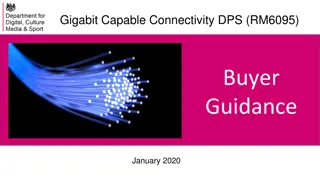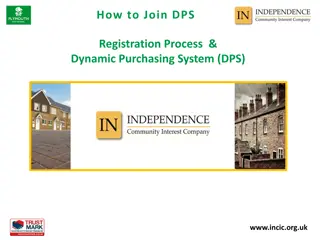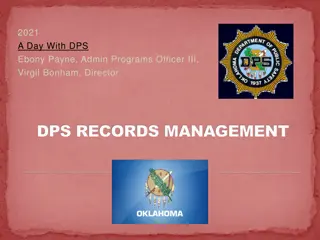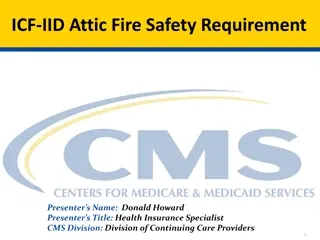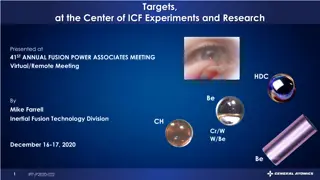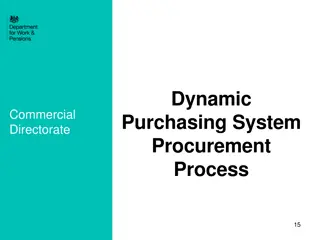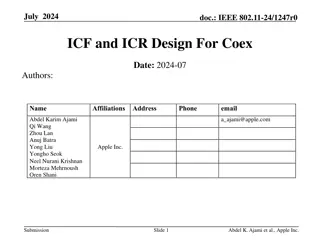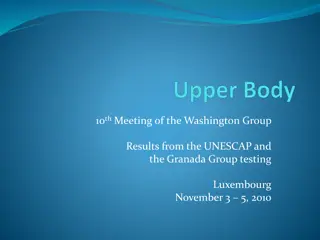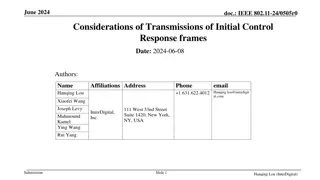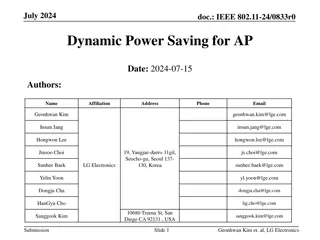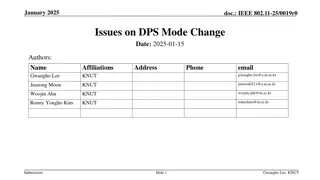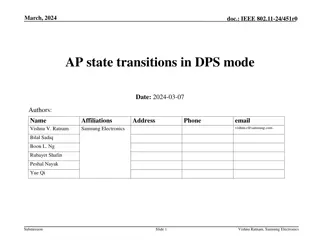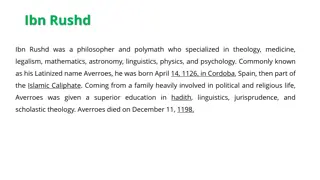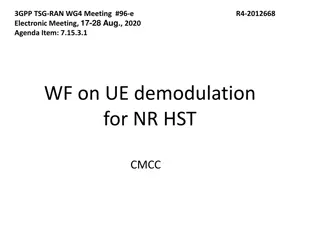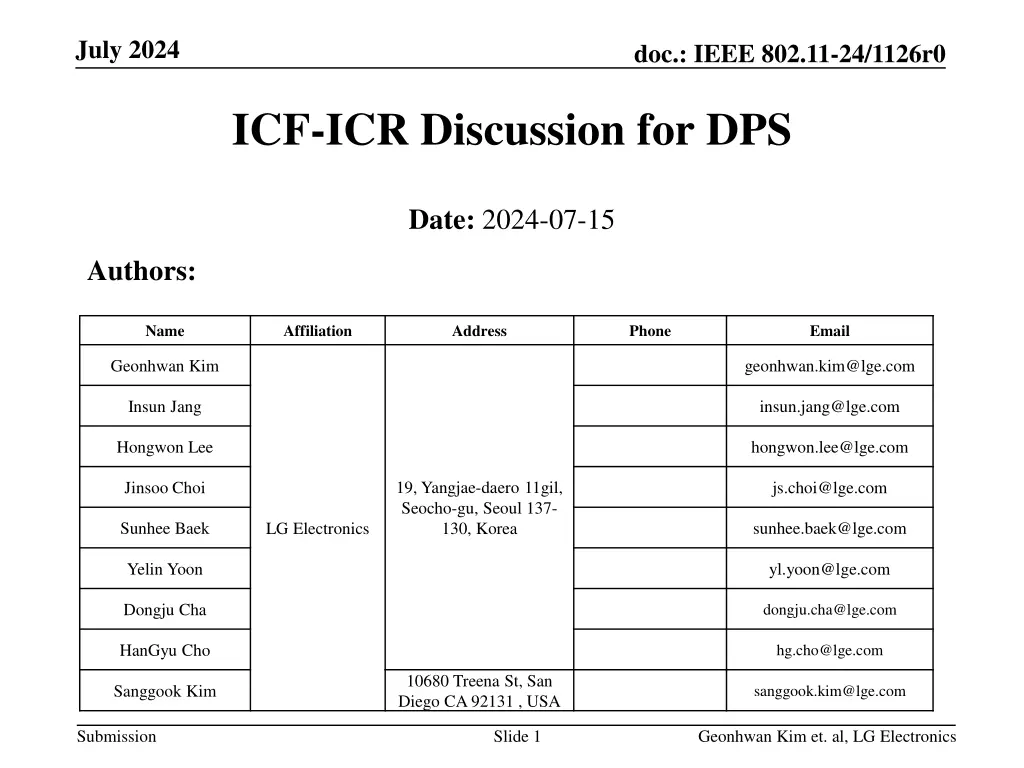
Dynamic Power Saving Discussion
Explore the discussions on defining a power save mode for STA in IEEE 802.11-24/1126r0, focusing on initial control frames (ICF) and initial control response frames (ICR) for dynamic power saving. Delve into potential contents in ICF/ICR, including padding and intermediate FCS, to facilitate transitions for DPS-supporting STAs. Discover insights on suitable candidate frames and features for efficient dynamic power saving implementations.
Download Presentation

Please find below an Image/Link to download the presentation.
The content on the website is provided AS IS for your information and personal use only. It may not be sold, licensed, or shared on other websites without obtaining consent from the author. If you encounter any issues during the download, it is possible that the publisher has removed the file from their server.
You are allowed to download the files provided on this website for personal or commercial use, subject to the condition that they are used lawfully. All files are the property of their respective owners.
The content on the website is provided AS IS for your information and personal use only. It may not be sold, licensed, or shared on other websites without obtaining consent from the author.
E N D
Presentation Transcript
July 2024 doc.: IEEE 802.11-24/1126r0 ICF-ICR Discussion for DPS Date: 2024-07-15 Authors: Name Affiliation Address Phone Email Geonhwan Kim geonhwan.kim@lge.com Insun Jang insun.jang@lge.com Hongwon Lee hongwon.lee@lge.com 19, Yangjae-daero 11gil, Seocho-gu, Seoul 137- 130, Korea Jinsoo Choi js.choi@lge.com Sunhee Baek sunhee.baek@lge.com LG Electronics Yelin Yoon yl.yoon@lge.com Dongju Cha dongju.cha@lge.com HanGyu Cho hg.cho@lge.com 10680 Treena St, San Diego CA 92131 , USA Sanggook Kim sanggook.kim@lge.com Submission Slide 1 Geonhwan Kim et. al, LG Electronics
July 2024 doc.: IEEE 802.11-24/1126r0 Introduction A Motion defining a power save mode for a STA that is a UHR Mobile AP or a UHR non-AP STA is passed [1]. Wherein the STA may transition from a lower capability mode to a higher capability mode upon reception of an initial control frame. The initial control frame (ICF) in the above motion for dynamic power save (DPS) is TBD, and TGbn is discussing ICF in other topics (e.g., IDC, DSO, Multi-AP coordination) as well. That is, ICF can be defined for use individually or commonly in each topic. In this contribution, we discuss about a details of ICF and initial control response frame (ICR) for dynamic power saving. How suitable some candidate frames of ICF/ICR are for the following features: Padding; ICF transmission from non-AP STA to AP, MU transmission; Room available for DPS information (if needed). Submission Slide 2 Geonhwan Kim et. al, LG Electronics
July 2024 doc.: IEEE 802.11-24/1126r0 Potential Contents in ICF/ICR for DPS Basically, there may be no need to include separate DPS content in the ICF/ICR. Similar to EMLSR, an STA supporting DPS operation/mode may transmit an ICF only for the purpose of changing the state of a DPS STA. When the ICF for DPS contains separate required operating parameters (for higher capability state), DPS STA receiving the ICF can reference these to derive additional power savings in higher capability state. The required operating parameters may be less than or equal to the max. parameters of the DPS STA. In this case, the contents that may be included in the ICF for DPS are as follows: Required operating parameters (e.g., BW, MCS, NSS for higher capability state) Intermediate FCS Present The ICR may contain the same contents for the purpose of updating parameters obtained from the ICF, but this requires further discussion. Submission Slide 3 Geonhwan Kim et. al, LG Electronics
July 2024 doc.: IEEE 802.11-24/1126r0 Padding / Intermediate FCS Padding/Intermediate FCS should be included in the ICF to provide sufficient time for the DPS STA to transition from a listening state to a higher capa. state. This is the most important factor in choosing an ICF. SIFS F C S ICF pad DPS-supporting STA Higher capability state ICR Listening state DPS-enabled STA Transition delay MU-RTS TF and BSRP TF basically include padding, and intermediate FCS can be designed within the TF [2, 3]. BlockAckReq (BAR) frame can also add/design padding/intermediate FCS as ICF for DPS. However, RTS cannot include padding/intermediate FCS to provide the time needed to transition from a listening state to a higher capability state. Submission Slide 4 Geonhwan Kim et. al, LG Electronics
July 2024 doc.: IEEE 802.11-24/1126r0 ICF transmission by Non-AP STA Given that BSRP TF and MU-RTS TF are used as ICFs in EMLSR, TF can be considered the first option of ICF for DPS. However, since non-AP STAs cannot transmit TF, if only TF is selected as the ICF for DPS, the AP (e.g., mobile AP) will not be able to operate as DPS. BAR or RTS frames may be options for ICF that non-AP STAs can transmit. However, if we keep in mind whether padding/intermediate FCS can be included, which is the most important factor for DPS, RTS has clear disadvantages. Therefore, in order to support the AP's DPS operation, the non-AP STA should be able to transmit ICF. An ICF that both AP and non-AP STAs can transmit may be defined, or Individual ICFs that AP and non-AP STAs can transmit may be defined. Submission Slide 5 Geonhwan Kim et. al, LG Electronics
July 2024 doc.: IEEE 802.11-24/1126r0 MU Transmissions in DPS scenario When using the TF as an ICF, it is also necessary to consider the scenarios in which the ICF is transmitted to multiple users. whether the AP can transmit ICF to legacy STAs and DPS-enabled STAs simultaneously. 1) ICF-for-MU transmission 2) ICF-before-MU transmission In order for MU transmission to occur in the sequence of 1) ICF-for-MU transmission, In other words, ICF can perform the role of existing TF and transition of DPS STA at the same time. ICF should be designed to avoid decoding issues in legacy STAs. If the ICF is not TF or there is a decoding issues with legacy STAs, 2) ICF-before-MU transmission sequence may be applied as an alternative. Legacy issues can be prevented, but separate ICF/ICR exchange is required. Submission Slide 6 Geonhwan Kim et. al, LG Electronics
July 2024 doc.: IEEE 802.11-24/1126r0 Room for DPS Contents: Trigger Frame If the MU-RTS TF includes information for DPS (shown in slide 3): Intermediate FCS Present field may be included in the Common Info field. Using EHT Reserved or Reserved bits Required operating parameters (e.g., BW, MCS, NSS for higher capa. state) may be included in the User Info field. This is because these are individual operating parameters for specific DPS users. Also, if the BSRP TF includes information for DPS: Intermediate FCS Present field may be defined in the Common Info field. However, there is not enough room in the User Info field of the BSRP TF for the required operating parameters. Special User Info field (i.e., based on special AID) can be utilized to append a DPS information. Alternatively, if we consider common ICF for TGbn, the Common Info field could contain a field indicating the ICF type (e.g., DPS, IDC, Multi-AP, etc.). In order to design a common ICF, much discussion is needed in terms of specific signaling methods and contents. Submission Slide 7 Geonhwan Kim et. al, LG Electronics
July 2024 doc.: IEEE 802.11-24/1126r0 Room for DPS Contents: Others RTS doesn't have room to include DPS information, but BAR frames might. There may be several ways to include DPS information in a BAR frame. Include a new DPS Information field following the BAR Information field; Use a specific Per-TID value for DPS and replace the Block Ack Starting Sequence Control field with a DPS Information field; Use a reserved value in Fragment Number field and replace the Block Ack Starting Sequence Control field with a DPS Information field. However, there are some important considerations when using BAR/BA. How can STA distinguish between DPS BAR and normal BAR? e.g., without any indication, a BAR transmitted during a low capability state is identified as a DPS BAR, and a BAR transmitted during a high capability state is identified as a normal BAR. There may be an option to define a new BAR frame variant (using reserved BAR Type). If DPS information needs to be included, how to signal it in Compressed BAR or Multi-TID BAR? Finally, it is necessary to consider how the ICR (i.e. BA) will be transmitted in relation to the above factors. Submission Slide 8 Geonhwan Kim et. al, LG Electronics
July 2024 doc.: IEEE 802.11-24/1126r0 Control Frame Candidates for DPS Candidates MU-RTS / CTS BSRP / BSR BAR / BA RTS / CTS Features ***Padding / Intermediate FCS O O O X O O **MU transmission X X *Non-AP STA to AP X X O O Room in ICF Available Available Available None Room in ICR None Available Available None If DPS information does not need to be included in both ICF/ICR, it is best to: AP to non-AP STA: MU-RTS (SU) & BSRP (MU) // Non-AP STA to AP: RTS If DPS information needs to be included in both ICF/ICR, it is best to: AP to non-AP STA: BSRP // Non-AP STA to AP: BAR However, to support AP s DPS operation, the padding issue should be addressed. Submission Slide 9 Geonhwan Kim et. al, LG Electronics
July 2024 doc.: IEEE 802.11-24/1126r0 Conclusion In this contribution, we discussed control frame for dynamic power saving (DPS). In order to provide sufficient time for an STA operating as a DPS to transition from a low capability state to a high capability state, padding should be included in the initial control frame (ICF). Since the trigger frame basically contains padding, the AP may use trigger frame as ICF. However, non-AP STAs cannot transmit trigger frame. Therefore, for a use case where a non-AP STA transmits a ICF, a method of specifying an ICF separate from the AP may be considered. Based on the analysis in this contribution, the common ICF transmitted by AP and non-AP STA can be determined. Alternatively, a separate ICF may be utilized for each STA depending on whether DPS information should be included or the SU/MU transmission scenario. Submission Slide 10 Geonhwan Kim et. al, LG Electronics
July 2024 doc.: IEEE 802.11-24/1126r0 References [1] 24/0171, TGbn Motions List Part 1 [2] 23/1873, Post-FCS MAC padding [3] 23/2003, Client power save Submission Slide 11 Geonhwan Kim et. al, LG Electronics

